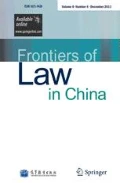Abstract
In the course of history, the meaning of fa (a Chinese character with an approximate meaning of “law”) has not been invariable, and its connotation in modern times has been enriched constantly, so as to incorporate many elements of ancient li (ceremony). If the modern concept of law, already changed and still changing, is to be used to mechanically compare and interpret traditional Chinese law, misunderstandings might arise. Actually, li and fa are indispensable components of traditional Chinese law, and the lack of necessary study of the li will prevent us from understanding and explaining the spirit of traditional Chinese law. In traditional Chinese law, “fa” usually refers to an institutional dimension, especially after Qin and Han dynasties, whereas li, especially li yi (moral basis for rites and ceremonies), is where the value and spirit of traditional Chinese law can be found.
Similar content being viewed by others
Author information
Authors and Affiliations
Additional information
Translated from China Social Science, 5th Issue, 2003 in Chinese
About this article
Cite this article
Zeng, X., Ma, X. A Dialectic Study of the Structure and Basic Concepts of Traditional Chinese Law and an Analysis of the Relationship Between li (ceremony) and fa (law). Front. Law China 1, 34–52 (2006). https://doi.org/10.1007/s11463-005-0015-9
Issue Date:
DOI: https://doi.org/10.1007/s11463-005-0015-9



